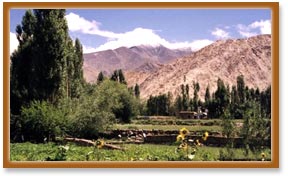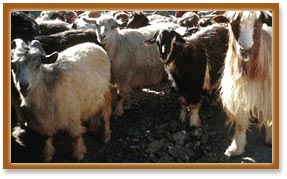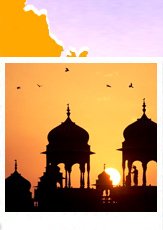 A cold desert, Ladakh has high-speed winds, dry atmosphere, roacky and uneven terrain and very low temperature. Fa-hian, a famous Chinese traveler who wandered to this land in 399 AD described Ladakh as 'the land where snow never melts and only corn ripens'. Situated in mightiest mountains of the world, Himalayas, Ladakh is situated at 4,600 m above sea level and has often been referred to as the 'La-pass' or 'Dakh-land' (land of passes). There are hardly any trees and vegetation in sight except for the few narrow valleys that are fertile. However, the sky is clear and beautiful as if we are somewhere other than Earth. Due to the high altitude of the region, the rarefied fauna that can be found here is of Oriental and Palearctic type. Along the riverbanks, one can see a greenish patch of land and it only near the snow line that one can see wild roses, willow groves and some herbs. However, above that, due to the rapid decrease in temperature, vegetation becomes stunted and sparse.
A cold desert, Ladakh has high-speed winds, dry atmosphere, roacky and uneven terrain and very low temperature. Fa-hian, a famous Chinese traveler who wandered to this land in 399 AD described Ladakh as 'the land where snow never melts and only corn ripens'. Situated in mightiest mountains of the world, Himalayas, Ladakh is situated at 4,600 m above sea level and has often been referred to as the 'La-pass' or 'Dakh-land' (land of passes). There are hardly any trees and vegetation in sight except for the few narrow valleys that are fertile. However, the sky is clear and beautiful as if we are somewhere other than Earth. Due to the high altitude of the region, the rarefied fauna that can be found here is of Oriental and Palearctic type. Along the riverbanks, one can see a greenish patch of land and it only near the snow line that one can see wild roses, willow groves and some herbs. However, above that, due to the rapid decrease in temperature, vegetation becomes stunted and sparse.Though it is not easy to spot wildlife in Ladakh, yet undoubtedly there are animals who have adapted themselves to survive in the harsh conditions such as rocky terrain, bitter cold, poor shelter and minimal vegetation. However, in harsher winters, ungulates migrate to lower regions and others including brown bears and marmots go in hibernation. Though, these animals too have been found to suffer from lack of oxygen at higher altitudes, most of them manage to cope up as their red blood corpuscles increases in number and so foes their acidity. Many of these animals especially the large mammals have a long fur to protect them from severe cold. Most common animals found here are - Yak (a wild ox), the largest animal found in Ladakh, Nyan, the largest sheep in the world, Bharal, the blue sheep and Urial, the smallest sheep in the world.

Yaks have long black fur and curved horns and weigh a ton. They spend their winters in the lower valleys in herds and move upwards in summers. Nyan is one of the most magnificent sheep in the world and is also known as Great Tibetan sheep. They hardly ever descend lower than 4,500 m and are only 200 in number and reside mostly in eastern Ladakh. Urial is also known as Shapu and they prefer grassy mountain slopes. However, their number is rapidly declining and being an easy target, need protection. Bharals are the most common sheep found in Ladakh and reside at altitude of 6,000 m and can be seen grazing in Alpine meadows in herds, mainly in summers. They are unique as they have morphological resemblance to both the sheep and the goats.









